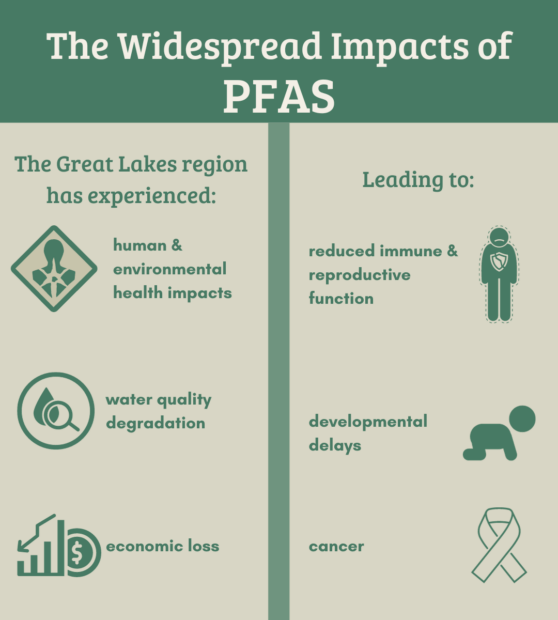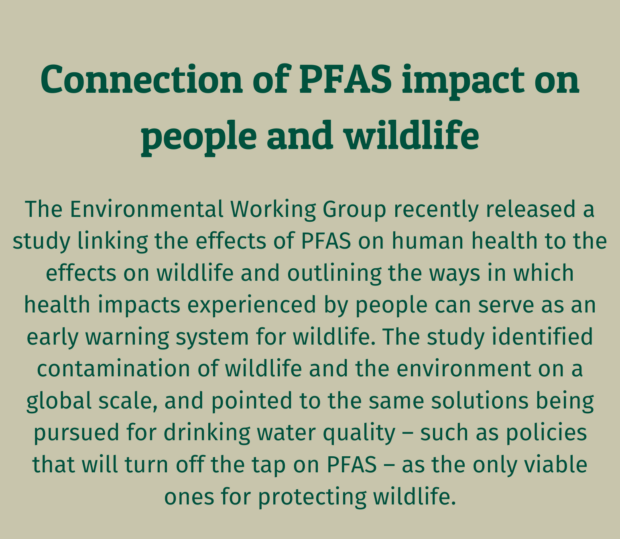We have much more to do and your continued support is needed now more than ever.
Great Lakes States Show Leadership in Development of PFAS Policies

With over 3,000 PFAS-contaminated sites in the U.S., these forever chemicals are a nationwide problem. But if you looked at a map of the known contamination across the country, the Great Lakes region would stand out.

Michigan currently has one of the highest number of PFAS-contaminated locations in the nation, and there are a couple of reasons for this. For one, the region’s history as an industrial powerhouse certainly plays a role. But the Great Lakes states have also been on the forefront of the search for PFAS; unfortunately, when you look for PFAS in the soil, water, and wildlife, we’ve learned that you find it. The region has been a model for studying PFAS, identifying contaminated sites, and passing legislation and policy to address it.
Many state-level victories to remove and remediate PFAS contamination have been achieved through the leadership, vision, and expertise of impacted communities in partnership with organizations that provide resources, advocacy capacity, and technical support. National Wildlife Federation is a founding member of one such collaboration in the region: the Great Lakes PFAS Action Network (GLPAN). Members of impacted communities work with us and our partners at the Ecology Center, and Michigan League of Conservation Voters to develop policy priorities, engage with lawmakers, and offer community organizing resources around PFAS contamination prevention, cleanup, and accountability.
There remains much work to be done, but by addressing some of the most pressing and urgent issues, the Great Lakes region serves as a shining example of how collaboration with communities, stakeholders, and policymakers can benefit the environment, people, and wildlife.
From bans on PFAS to reparations to the impacted community members, Great Lakes States are leading the way to repair this issue at the state level.
Comprehensive Policy Wins: PFAS Bans
In the past three years we have seen some of the most innovative policies come out of the region to address PFAS. Those include PFAS purchasing bans, such as the first-in-the-nation, state-level procurement policy in Michigan under Governor Gretchen Whitmer that directs the state to avoid purchasing products containing PFAS when alternatives are available.
Other states, such as New York and Illinois have banned the incineration of PFAS. And Minnesota leads the way with the strongest ban on PFAS in products, which passed this year. The law bans the sale of products with intentionally-added PFAS beginning in 2025, restricts all unnecessary PFAS uses by 2032, and establishes reporting and disclosure requirements for products containing PFAS beginning in 2026.

Michigan is expected to follow suit this legislative session; a bill package addressing multiple uses and impacts of PFAS is anticipated in the House, which is expected to include similar legislation to ‘turn off the tap’ on PFAS and limit their production and use in the first place.
In addition to these comprehensive bills some states in the region like Illinois and Michigan are also pursuing legislation that targets specific uses, such as bans on intentionally added PFAS in food packaging and cosmetics and amending procurement policies to ban the purchase of certain products with intentionally added PFAS by state agencies.
Policy to Address Firefighting Foam and Gear
The need for bans on products containing PFAS is not limited to household and consumer goods, but extends to commercial, safety, and defense uses. Firefighting foam, specifically Aqueous Film Forming Foam (AFFF), is a major source of PFAS contamination as PFAS chemicals are used to suppress fires. Firefighting foam is a component of Minnesota’s comprehensive PFAS ban, which prohibits the sale, distribution, and use of Class B firefighting foam containing PFAS. Illinois also enacted similar legislation.
Similarly, legislation enacted in Michigan prohibits the use of fire fighting foam in training practices. In an effort to protect surrounding resources from the effects of AFFF after their use, Illinois and Michigan also enacted policies to tackle the disposal and storage of PFAS by creating a take-back program for fire departments disposing of foam containing PFAS.
In addition to AFFF, firefighting gear also contains high levels of PFAS. Because of their exposure to elevated levels of PFAS, firefighters have served as leaders in pushing policy that would limit the use of PFAS in foam and gear. In Indiana, a bill was passed that requires gear purchased by fire departments to be labeled whether or not it contains PFAS, as well as a bill that will establish a biomonitoring program to analyze blood samples of current and former firefighters.
Policy to Hold Polluters Accountable
Putting the onus on community members to remedy their own PFAS contamination won’t work. Polluters must be held accountable to prevent contamination in the first place. To that end, the region has seen several bill packages introduced that would hold polluters accountable. These potential policies address health impacts and access to clean water, while demanding accountability, reparations, and safeguards for PFAS use.
The Michigan legislature will take up a polluter accountability bill package this session to adjust the Statute of Limitations for civil actions, enabling those exposed to higher levels of hazardous substances to sue, even without diagnosis of an illness. While these bills extend beyond just PFAS contamination, if passed, they would create and strengthen avenues for individuals impacted by PFAS to pursue legal action against polluters.

Meanwhile, additional policies are being explored and crafted to support impacted communities, including GLPAN priorities to require insurance companies to cover the costs of blood testing for communities exposed to elevated levels of PFAS; ensure access to alternative sources of clean water if a community experiences PFAS contamination in their drinking water; and provide a financial safety net for farmers who lost income or assets to PFAS contamination.
Policy to Protect America’s Farmers
Farmers in many states have been severely impacted by PFAS. Around the Great Lakes states, farmers who have used biosolids also known as sewage sludge as fertilizer on their farms may have inadvertently contaminated their land with high levels of PFAS. Unfortunately, the use of sludge is marketed as an affordable source of fertilizer for farmers, but the real cost has resulted in the loss of cropland, livestock, and income when their land, crops, and/or livestock are found to be contaminated with PFAS. In response, community members, including farmers in GLPAN, are calling for funding for farmers who suffer as a result of PFAS contamination.
Collaborative work between state lawmakers, impacted community members, and environmental and public health organizations has advanced critical policy to limit the presence of PFAS in our homes, protect water quality from contamination, and strengthen accountability from polluters. Federal action is unlikely to take place in Congress in the near future; with that in mind, it’s imperative that states take action on their own to address PFAS contamination. The Great Lakes are a great example.





















